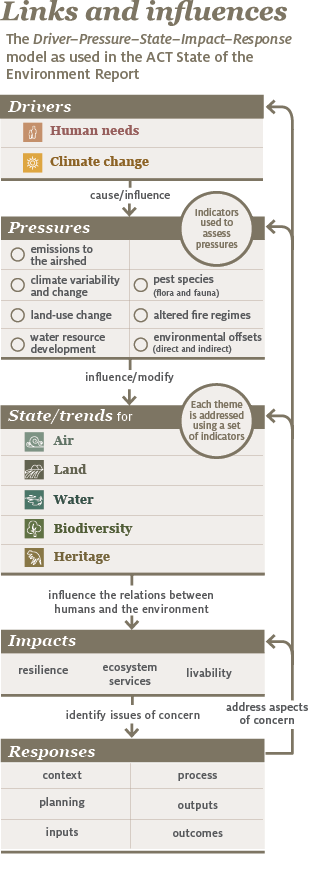You cannot get through a single day without having an impact on the world around you. What you do makes a difference, and you have to decide what kind of difference you want to make.
– Jane Goodall
Every four years, the Commissioner for Sustainability and the Environment prepares a State of the Environment Report for the Minister for the Environment. The 2015 Report covers the reporting period 1 July 2011 to 30 June 2015.
The report assesses the air, land, water, biodiversity and heritage values of the Australian Capital Territory (ACT), while recognising that these values are inextricably connected to the region biophysically, politically, socially and economically.
The report is based on the Driver–Pressure–State–Impact–Response (DPSIR) model (below), which assesses the:
- Drivers, which are the forces that increase or mitigate pressures on the environment (eg population growth or climate change)
- Pressures, which are the direct stresses on the environment that occur as a result of drivers (eg pollution, reduced rainfall)
- State of the environment, which is the condition of the environment (including trends over time)
- Impacts, which are the effects of environmental degradation
- Responses, which refers to the human responses to the environmental situation (eg the legislation, policies and programs of government agencies).

Figure 1 The Driver–Pressure–State–Impact–Response (DPSIR) model
The report is structured with the aim of providing answers to four questions.
1 What are the drivers and pressures on our environment?
In this report, meeting human needs – including the need for development of housing and infrastructure – and climate change are considered to be the major drivers of environmental change in the ACT.
2 How is our environment faring?
The report presents assessments of the current state of five themes for the ACT – air, land, water, biodiversity and heritage – and the impacts of pressures on each of these themes.
Each theme uses a set of indicators to assess state, trend and pressures. Graded assessment summaries are included and provide snapshots of key information.
Each theme also includes an assessment of resilience, an overview of key government policies and programs, and case studies detailing both ACT Government and community-led initiatives aimed at maintaining and improving aspects of the environment related to each theme.
3 What does a changing environment mean?
The DPSIR model can be used to explain the interactions between humans and the environment, and answer questions such as ‘What do changes to biodiversity or air quality mean to our way of life?’
This chapter of the report aims to address these considerations by providing indicative and preliminary assessments on:
- livability (a way to assess how attractive the ACT is compared with other places in terms of the perceived quality of life)
- ecosystem services (a way to identify the ways in which the environment provides goods and benefits to people in the ACT, which both support and fulfil lives)
- resilience (a way to consider how well the coupled socioecological systems in the ACT might be able to cope with expected and unexpected pressures and shocks without losing the essential characteristics of these systems).
4 What are we doing and what effect is it having?
To assess the effectiveness of the management of the ACT’s environment, the Office of the Commissioner for Sustainability and the Environment commissioned an independent expert assessment of existing ACT Government measures to protect and manage the environment. The Commissioner accepted their assessment and it forms the basis of Chapter 10 of the report.
The report also includes a set of recommendations to the Minister for the Environment on matters relating to the condition and management of the ACT environment. These recommendations address both significant and systemic issues, and aim to focus government management actions where they are likely to have the greatest effect. Recommendations are included for climate change, human needs, air, land, water, biodiversity and heritage.